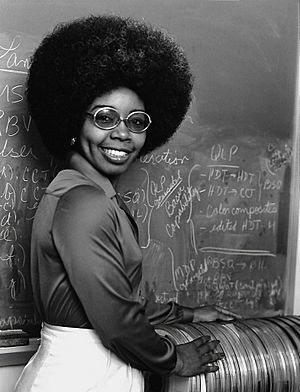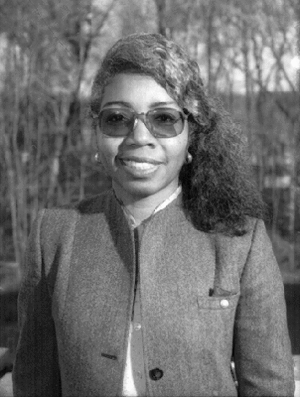Valerie Thomas facts for kids
Quick facts for kids
Valerie Thomas
|
|
|---|---|

NASA photograph of Thomas next to a stack of early Landsat Computer Compatible Tapes, 1979
|
|
| Born | February 8, 1943 Maryland, United States
|
| Alma mater |
|
| Known for | Inventor of the illusion transmitter |
| Scientific career | |
| Institutions | |
Valerie L. Thomas, born on February 8, 1943, is an amazing American scientist and inventor. She created something called the illusion transmitter, and she got a special patent for it in 1980. She also helped create the digital formats for pictures used by NASA's Landsat program in its early days.
Contents
Early Life and Education
Valerie Thomas grew up in Baltimore, Maryland. She finished high school in 1961. This was a time when schools were just starting to welcome students of all backgrounds.
She went to Morgan State University. There, she was one of only two women studying physics. Valerie was excellent in her math and science classes. She graduated with top honors in physics in 1964.
Valerie's Career at NASA
Valerie Thomas started working for NASA in 1964. She was a data analyst. This meant she helped organize and understand information.
Developing Computer Systems
From 1964 to 1970, Valerie created computer systems. These systems helped control satellites in space. She also helped with the Landsat program. This program uses satellites to take pictures of Earth from space. Her work helped scientists see our planet better.
Predicting Crop Yields
In 1974, Valerie led a team of about 50 people. They worked on a project called LACIE. This project was a team effort with other big organizations. LACIE showed that satellites could help predict how much wheat would grow around the world. This was a huge step forward!
Inventing the Illusion Transmitter
In 1976, Valerie went to a science show. She saw an amazing trick: a light bulb looked lit, but it was not in its socket! This trick used another light bulb and special concave mirrors.
This illusion made Valerie curious. She started researching it in 1977. She did experiments to see how mirrors changed what you saw. Through her discoveries, she invented the illusion transmitter.
On October 21, 1980, she received a patent for her invention. NASA used her device. Later, this technology was used in many other things. This includes screens for surgery tools and even televisions. Valerie became a leader in the Space Science Data Operations Office at NASA. Her invention has even appeared in children's books, TV shows, and video games.
Connecting Scientists Worldwide
In 1985, Valerie managed NASA's computer facility. She helped combine two separate computer systems into one. From 1986 to 1990, she managed the Space Physics Analysis Network (SPAN).
SPAN was a network that connected scientists' computers. It grew from about 100 computers to 2,700 worldwide. Valerie's team helped create this network. It made it easier for scientists around the world to work together.
By 1990, SPAN became a big part of NASA's science network. It even helped lead to today's Internet. Valerie also worked on projects about Halley's Comet, ozone research, and Voyager spacecraft.
Mentoring Young Scientists
Valerie loved to help young people. She mentored students in a program called Mathematics Aerospace Research and Technology Inc. She often spoke to students of all ages. She visited schools and national meetings.
She also judged science fairs. She worked with groups like the National Technical Association (NTA) and Women in Science and Engineering (WISE). Valerie retired from NASA in August 1995.
After NASA
After retiring, Valerie continued to help young people. She mentored them through different science programs. In 2018, Valerie Thomas was honored. She was added to the National Inventors Hall of Fame. This recognized her important work in satellite communication and remote sensing.
Awards and Recognition
Valerie Thomas has received many awards. These include the Goddard Space Flight Center Award of Merit. She also received the NASA Equal Opportunity Medal.
See also
 In Spanish: Valerie Thomas para niños
In Spanish: Valerie Thomas para niños


